Hoyer Lift vs. Ceiling Lift: A Guide to Safe Transfers
Posted on by Eric Rubel

Before recommending a Hoyer lift for patient/client transfers, it’s important to fully understand the challenges of using this type of equipment, and more importantly, why an overhead ceiling lift is often a better solution.
A Hoyer Lift is a brand of patient lifts that has become a generalized term used in conversation – much like other trademarked brands like Kleenex, Thermos, and Escalator. Many professional caregivers are quick to recommend a "Hoyer Lift", when in fact they could be referencing a number of patient/client lift systems available and that could be made by other manufacturers besides Hoyer.
What is a Hoyer Lift?
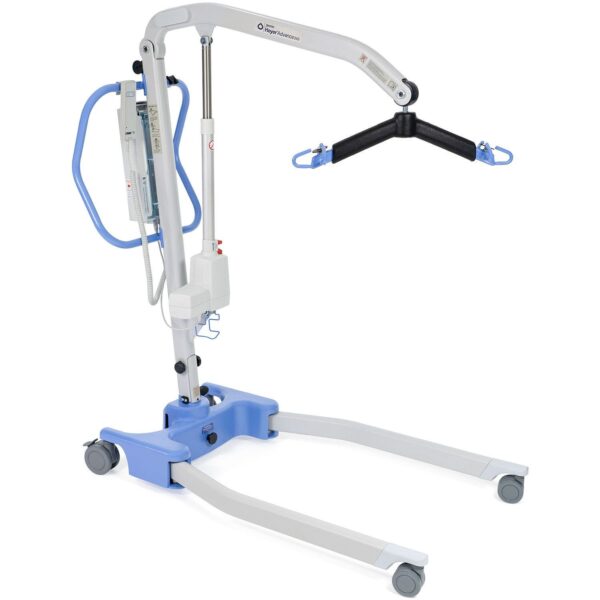
A Hoyer Lift is a mobile floor lift system that rolls on wheels and is intended to help lift, suspend and transfer a medically dependent person from a bed, toilet, bathtub, shower or a wheelchair. These lifts are commonly used in hospitals, physical therapy centers, schools, and even in a home, and have been the standard for the past two decades. It spares a caregiver’s back from having to manually lift a person. The Hoyer does all the heavy lifting.
5 Problems With a Hoyer Lift (Mobile Patient Transfer Lift)
1. Requires a caregiver to operate – without assistance, it is impossible for a person with limited mobility to use a mobile patient lift on their own. This sacrifices one’s independence.
2. Rolls on the floor on wheels – if the floor is not smooth or cluttered, then rolling the mobile patient lift around to desired transfer point could become difficult. They don’t work well on carpet, with thresholds, or at doorways due to their wide base. The same applies when rolling it under a bed. A bed must be specially designed to accommodate the long legs of the lift so it can roll under it.
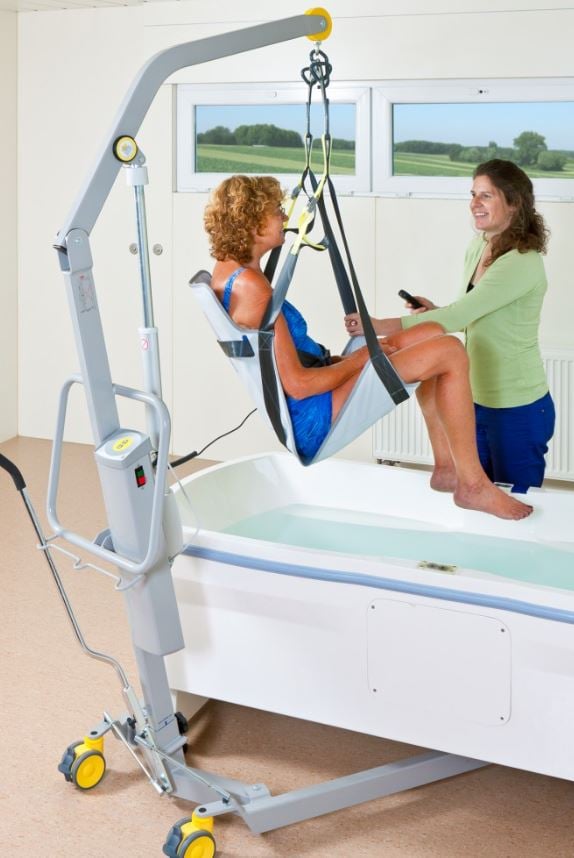
3. Difficult to use in a bathroom – bathroom areas are cramped enough as it is. The sheer size of the mobile patient lift system would be hard to maneuver over a toilet, bathtub or shower in small bathrooms. It becomes more challenging since the caregiver must also accompany the person being transferred.
4. Hydraulic or electric operation – some Hoyer lifts are hydraulic, meaning that a caregiver must manually operate the lift with a little elbow grease. While this is still easier than manually lifting a person as a whole, the pumping of a lever to lift can become tiresome over the course of the multiple transfers required in any given day. Electronic lifts are easier to use and require less effort, but they also come with a higher price tag.
5. Uncomfortable – Mobile patient lifts can be down right uncomfortable, even with the variety of slings available. This can become a very painful experience for people that are unable to bend at joints freely, or that are sensitive to touch or being wrapped tightly.
Why is a Ceiling Lift Better Than a Hoyer Lift?
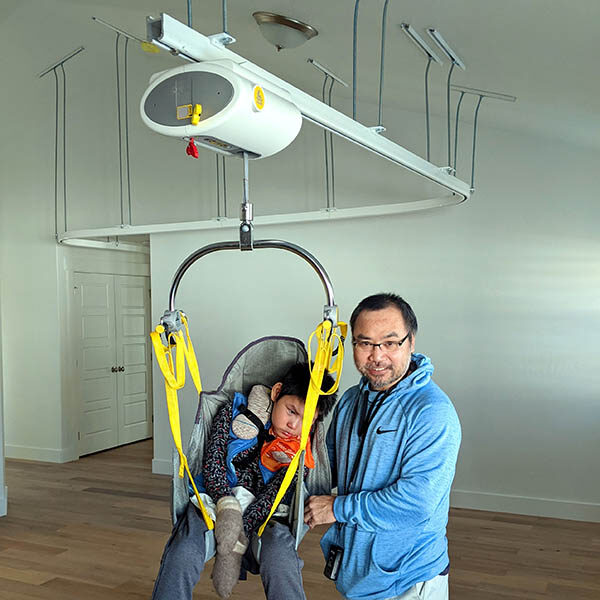
Overhead Track-Mounted Ceiling Lift System
Overhead ceiling lifts are a professional strength lifting technology. The main difference between the lifts of the past, like Hoyer Lifts, and today’s technology is the personal fit and advanced options that allow for in-home use, single transfers to multiple locations, and independent use. Ceiling Lifts are superior to Hoyer Lifts in many ways and offer the following benefits.
1. Easiest transfers & Saves Space – provide the easiest transfers because the lift takes no floor space, and the ceiling-mounted track is designed to travel over all transfers and from room-to-room in a home or throughout various areas of a room in medical facility.
2. It’s the same lift – the lift become routine, predictable and more expected, and comfortable over time for the person being transferred, and for whomever is operating the lift, if required.
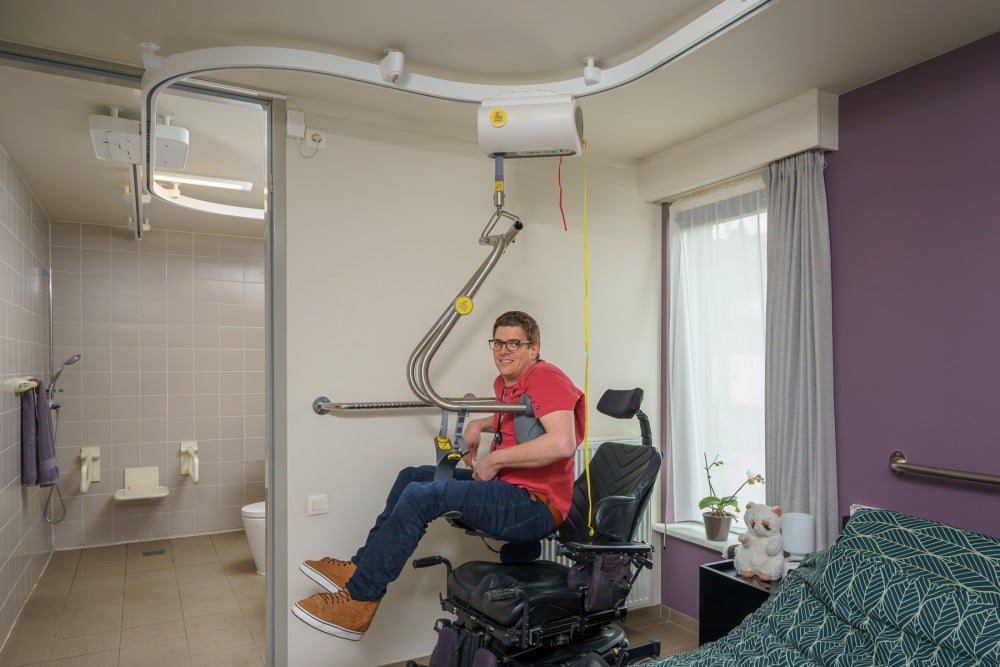
3. Gain independence – in some instances, a person can transfer themselves independently, depending on their mobility.
4. Fast installation – ceiling lifts can be installed same day, in some cases, and are far easier and cheaper than other types of home modifications that may require construction.
5. Take it with you – overhead, ceiling-mounted lift systems can be taken down and reinstalled in a new home, business or medical office.
6. Save time – this is probably one of the most attractive benefits of a ceiling lift. Since transfers are easier, and the transfers tend to be the same regardless of the final destination point (chair, tub, shower, etc.), this saves everyone time because manual adjustments are minimized.
The 3 Varieties of Ceiling Lifts
1. Basic Ceiling Lift – includes remote controls for up and down. Travel along the ceiling track is manual and requires a caregiver or assistance. The track can be placed over all the needed transfer points.
2. Portable ceiling lift – a small motor that can move from a track over the bed to a track in the bathroom, and elsewhere in the living area. This lift provides up and down options, but traveling along the track requires caregiver or assistance.

3. Independent Ceiling Lift – includes all the options of the basic ceiling lift AND a extra lateral motor that allows the user to push a button to travel anywhere along the track without assistance. Includes options like power traverse rails, turntables, and multitrack and multiroom lifts.
The Advanced Positioning of Ceiling Lifts
Ceiling lifts are only as good as what touches one’s body, and this includes slings, spreader bars, and a Body Support system. Slings are the most popular way to adjust positioning and in providing easy transfers. However, there is much more variety in slings that most professionals see. Most slings are available in a mesh, solid fabric, or a plastic material (PVC) and can include padding or not. The mesh is typically used in the bedroom and can be washed to keep it clean. The PVC material is best in the bathroom or when repeated use requires a material that will always be dry. The most common styles of slings for transfer lift systems are listed below.
Slings for Ceiling Lifts
1. Parachute fabric sling – offers complete support, suitable for all users. This gives better support and a safer feeling to the user and is made of a light, thin, soft material.

2. The standard sling – Typically the most universal type of sling, it fully supports the body and has a cut-out for toileting. And, it can be easily attached or removed from the patient when they are safely positioned into their wheelchair. The padded legs feel soft and offer ideal support at the same time. This padding also prevents the leg flaps from binding or bunching up. Positioning handles are sewn into the back of these slings. The standard sling is available with or without a crescent-shaped head support. When more targeted head support is required, a six strap models is ideal. A version without padding is ideal when the sling needs to remain underneath the user.
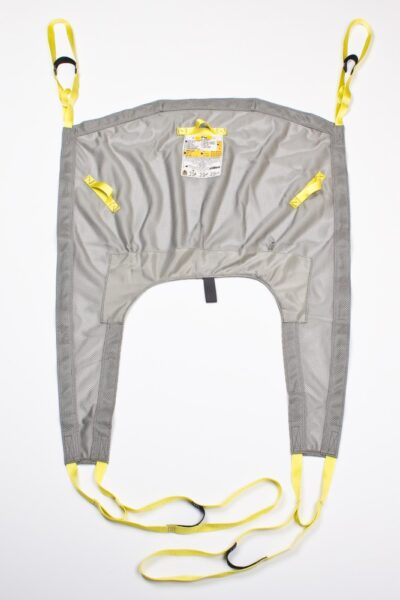
3. The hygiene sling – for transfers to the toilet. Sometimes referred to as a toileting sling, this model is specially designed to make toileting possible while in the security of the sling. It is so easy to put on that sometimes it can even be used independently. The large cut-out area behind the thighs and up the lower back allows access to the clothing so that the belt or waistband can be loosened and the user’s pants can be removed while a person is in the sling. A wide Velcro belt is closed around the user’s abdomen for extra safety and support. An optional head support is also available.

4. The bathing sling– for transfers to the bath or pool. The shape of the bathing sling is identical to that of the hygiene sling – only the material is different. The bathing sling is made of maintenance-friendly, latex-free, anti-slip, synthetic material that can be easily wiped dry. The bathing sling can be used dry as an alternative to the hygiene sling. An optional head support is also available for the bathing sling.
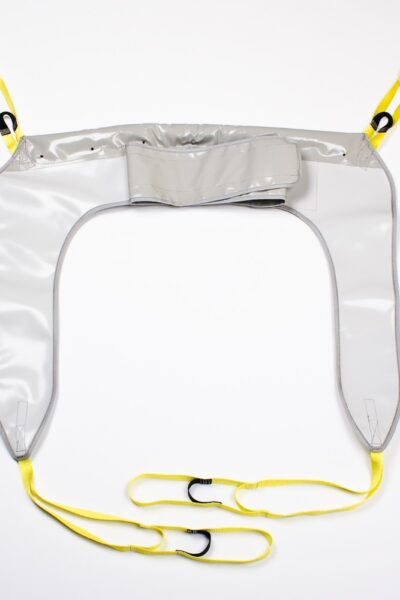
5. The amputee sling – several slings work specifically for this purpose. They offer comfort and are intended to hold the body in complete balance. For persons with a double amputation, an adapted, rectangular sling is used. This sling has no head support.
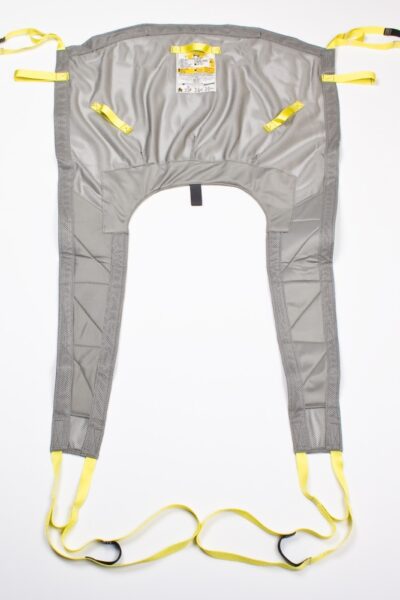
6. The seat sling – the seat sling, made of a synthetic latex-free material, is useful for people who can stand but lack stability and balance. It can be used in the home or institution. It can support the user in a 90 degree seated position with a firm seat and back support. It can also recline to other positions and is ideal for leaving underneath the user when lying in the tub. The perforated seat lets the water through. It can be attached to any of our systems. An optional security belt is available for those with poor balance in a seated position.
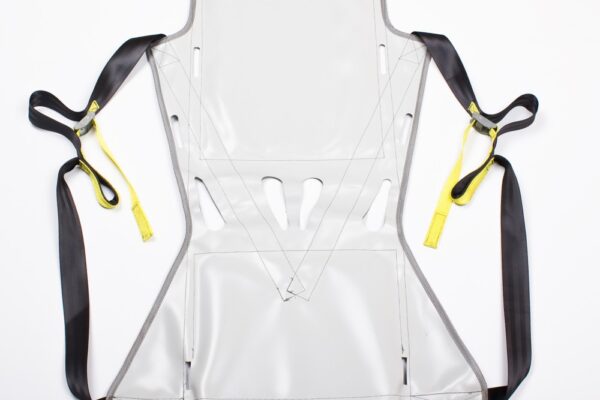
7. The walking harness – support for gait training and ambulation The ability to adjust this harness with numerous belts and buckles makes it an ideal tool for properly supporting the shoulders, stomach, chest, and legs during gait training and ambulation. The safety strap further supports the user if fatigue is a problem during training.
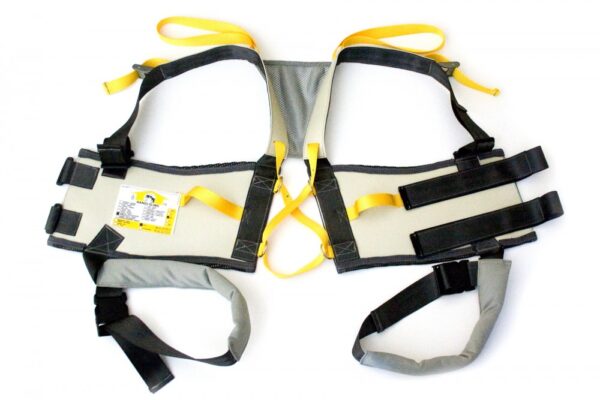
Spreader Bars for Ceiling Lifts

Most lifts offer innovative two and four-point spreader bar systems. When combined with the multi-loop features on the advanced slings, the caregiver has an opportunity to perfectly distribute the patient’s body weight for maximum comfort and functionality. On the four-point spreader bar system, the patient can be positioned in a reclining, sitting or inclined position.
The position is determined by using a combination of back and front loop attachments. For example, the longest length in the front and the shortest length in the back will create a sitting position. The spreader bar is bow shaped so that the patient’s head is out of the way during the initial lifting. Once the patient is lifted, this curved shape also prevents the patient’s vision from being obstructed so the actions of the caregiver can be easily followed. The sling is quickly and safely put on and removed, saving time and energy for the caregiver. Also, there is no need for the patient to sit in the sling all day.
Advanced Lifting Technologies
Multiroom Lifts, Multitrack lifts, Self Supporting Track Lifts, and Traverse Rail/transfer Anywhere Lifts. Room to Room systems eliminates extra transfers by allowing the user to move from bed to toilet or tub/shower, instead of having to make the intermediate transfer to a shower or wheelchair. This is much faster and easier for patient and caregiver.
Multitrack Lifts allow a person to travel seamlessly between rooms, a multitrack can be used as well as a switch or turntable. A multitrack system allows a user to turn in a hallway or room and move to any part of their living space without assistance. When the user moves into the turntable the batteries on the lift power the turntable and allows one to enter any of the 4 track options.
Body Support for Ceiling Lift Self-Transfers
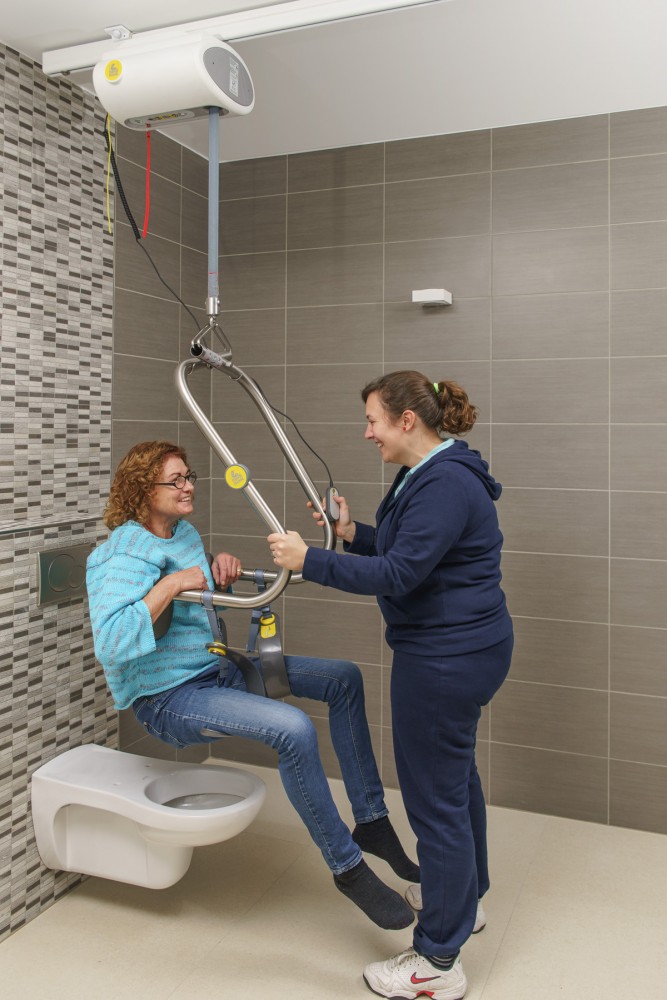
With a ceiling track system and a body support, a person with a limited range of motion and sufficient muscle tone can have an opportunity to transfer independently and move from room to room on one continuous track. Universal sizing is an attractive attribute. The self-adjusting curve-around cups are large enough for heavy adults and small enough to fit most children. This makes the body support a good investment for a growing child or where multiple people are using the system. The Body Support system is simple to attach.
There may be times when the body support needs to be removed for transport or to attach another lift system altogether. The safe and secure hook attachment is easy for the attendant to remove or re-install without help. Safe and hygienic, the body support is made of light and very sturdy and made from steel yet it has a weight capacity of 400 lbs. All components are watertight and rust resistant which makes it perfect for use in bathing and swimming. It can be easily disinfected between uses or dried easily when wet, making it far more practical and hygienic than slings.
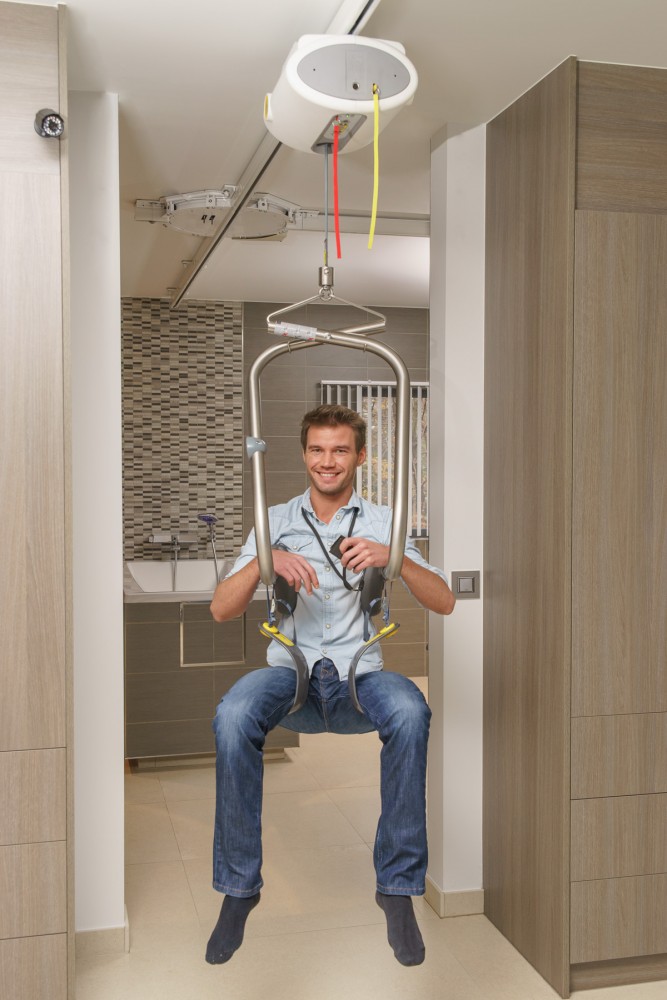
The Body Support offers comfort and ease of use The direct application from the front of the user and the simple placement of the curve-around poly cups and thigh supports make the body support very easy to use. The automatic closure of the “hands” when the user is being lifted is directly proportionate to the user’s weight. The security of being supported around the chest and under the thighs translates to a comfortable feeling for the user.
As one can see, there are many possibilities that can provide quality of life for most people facing mobility challenges. If you'd like to learn more about safe transfer lift systems or to set up a free consultant, please call us at (888) 714-1930
